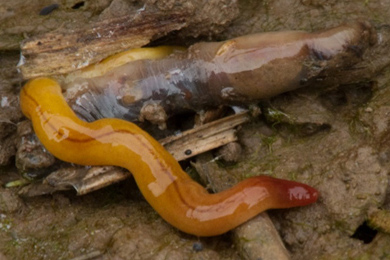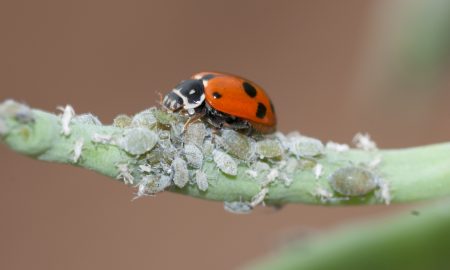Does an abundance of flatworms spell trouble for slugs?
In the moist grey clay soils west of Mudgee in NSW Central Tablelands, prominent populations of ‘green slugs’ have been recorded around the base of plants. On closer examination, these have turned out to be a species of green flatworm or terrestrial planaria.
The good news is that flatworms are known as predators of slugs and other soft-bodied invertebrates (such as worms).
According to SARDI entomologist, Dr Michael Nash, flatworms also occur from time to time in South West Victoria, mostly yellow flatworms.

About Flatworms
Terrestrial flatworms, also called land planarians, are entirely free-living carnivorous animals.
In Australia, there are known to be about 300 species of which 140 are described, mostly from the tropics.
Terrestrial flatworms are generally confined to humid areas where they hide beneath leaf litter during the day, emerging at night to feed. However, a few species do exist in lower rainfall areas.
Flatworms vary substantially in size, from 5 mm to over 100 mm in length.
Generally flat, long, and tapered at either end, some species are brightly coloured and striped. Most flatworms have two or more pinpoint-sized eyes.
Land planarians are not segmented like earthworms, but they do reproduce by fragmentation at the tail end. The tip will attach itself to something in the soil, and the parent worm will pull away. The fragment is able to move immediately and will develop a head within 10 days. Fragmentation is the primary form of reproduction, but the flatworm will also lay eggs in a cocoon. Eggs will hatch about 21 days later (depending on temperature and moisture conditions).
Flatworms can vary widely in colour and are active and colourful when observed live.
Collecting and preserving flatworms is difficult. Their bodies are easily damaged when handled, and they are very sensitive to heat and desiccation; captured flatworms may die quickly and decompose within hours. When fixed in alcohol, flatworms lose their shape and colours, so identification is based on the internal anatomy.

Predation
Terrestrial flatworms are generally known to be predators that attack a range of small animals including slugs, snails, earthworms and other soil invertebrates.
Flatworms hunt actively in the soil, moving along crevices and burrows, as they follow the scented trail of their prey.
The mouth of a flatworm is not on its anterior (head) end, but halfway down the length of the body, in the centre of the ventral surface. Multiple mouths can be present.
The flatworm feeds by attaching itself to its prey with mucus, secreting digestive juices, and digesting the prey externally. Small prey can be swallowed whole.
When food is not available, flatworms appear to be able to survive for over a year without feeding.
Dr Michael Nash’s field experience suggests that flatworms of the yellow species are probably more scavengers of slugs than active predators.
In any case, their numbers rarely get high enough to trouble a reasonable slug population, partly because they can be cannibalistic and self regulate their own populations.
Acknowledgements
Source of field reports of flatworms
Dr Michael Nash – Researcher, SARDI (Adelaide)
Phil Stoddart – Consultant, Stoddart Agriculture (NSW Central Tablelands)
References
Massey University (2015). Guide to soil invertebrates – Turbellaria. http://soilbugs.massey.ac.nz/turbellaria.php
Cover image: Photo by Reiner Richter, CC By NC SA





